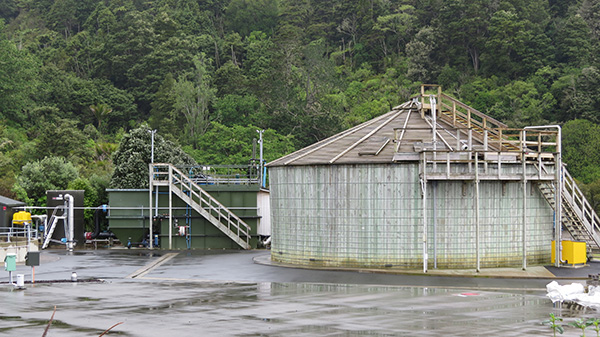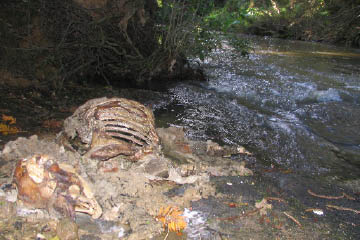Wastewater plant upgrade not exactly nothing

Eight Years On: The new peak flow wastewater treatment system installed at the Warkworth wastewater treatment plant in 2008 has made water contact recreation in the Mahurangi River, following periods of high rainfall, far more sanitary. Rodney District Council
Many reading A Muddy Brown Colour would have suspected, of course, that Rodney District Council was in fact doing something about its notoriously leaky old sewerage system.
Most, however, would be astonished to learn the half of the council’s short, medium and long-term strategy for wastewater treatment in the Mahurangi—I say ‘half’ deliberately, because some of the medium, and much of the long-term, strategy is yet to be determined.)
My first thought when reading Rebekah Leibeziet presentation was that the Stream Rescue Team would benefit from a detailed exploration of Warkworth’s wastewater treatment system—if the council performance is going to be criticised, the more accurate that criticism is, the more effective it will be. But then I reflected that ‘educating’ the children only, would be to miss an obvious opportunity.
Rodney District Council is firmly committed to involving stakeholder groups in developing the Mahurangi wastewater strategy, a process that is shortly to begin in earnest. As a stakeholder group, young people have a particularly valid case for being involved in the development of the strategy, given the emphasis on the long term. When the, yet to be established, Mahurangi wastewater strategy working group gets to go about its business, the participation of youth representatives in that group will challenge the other stakeholders in all sorts of ways. Certainly it will challenge expedient, world-weary, thinking—same old, same old won’t wash with the young!
When Warkworth wastewater treatment plant was initially designed, in the early 1970s, the Mahurangi catchment stakeholders were presented with a fait accompli. Nothing sinister in that, that was just the way council and the engineers went about doing things, and mostly getting it right. But in Warkworth’s case, the town council and its engineers didn’t get it right, and subsequent councils, and the receiving environment, have been compromised ever since. Led by Warkworth’s water treatment plant operator, Wilfred Allan, the stakeholders argued that the style of treatment plant inherently lacked the capacity to cope with extreme rainfall events.
Sadly, the only consequence of the very strong case that was made for a combined scheme—with Snells–Algies—with reserve capacity to buffer those events, was that the oyster farmers downstream were required to pay for an intensive, on-going water testing programme. In one regard, the engineers had been right. The long-suffering Mahurangi River acted sufficiently well to further treat the effluent—as the engineers referred to it: ‘the buffer zone’—that the pathogens actually impacting on the oyster farms after heavy rain, were from farmland, not the overflowing treatment plant.

Extreme Animal Waste: Swimming in any river, regrettably, will continue to be something of a lottery until we become a whole lot more vigilant—the Mahurangi River upstream of both the water and wastewater treatment plants, 2007. photographer Thomas Wilding
Since the 1970s, Warkworth’s wastewater system has swallowed considerable public monies but continued to be plagued by those fateful design decisions and by a failure to sufficiently upgrade the old leaky sewers. Now, finally, by December 2008, the plant will have the capability of adequately treating all the wastewater, before it hits the river.
In a perfect world, the stakeholders would have been part of the decision-making that led up to the signing of the contract with Veolia Systems, for the design and installation of this new system. But consultation has become something of a beast, and one that all too readily bites the hand that directly feeds it—not to mention the over-priced gourmet pet food demanded, to clumsily continue the beast analogy. Under mounting pressure from the regional council, the district council had little choice but to go ahead with the upgrade, choosing modular equipment so that if the long-term strategy suggests, for example, a combined wastewater treatment plant at Dawson Creek, it can be re-sited there.
Frustratingly, the timetable for the Mahurangi wastewater strategy is yet to be determined, but consultants have commenced the work of collecting all the information that the working group will need to have to hand.
If Rebekah, or another representative of the Stream Rescue Team, is willing to be part of that working group, it is hard to see how the council or the stakeholders could fail to embrace the opportunity.
See also letter to the Mahurangi Magazine
